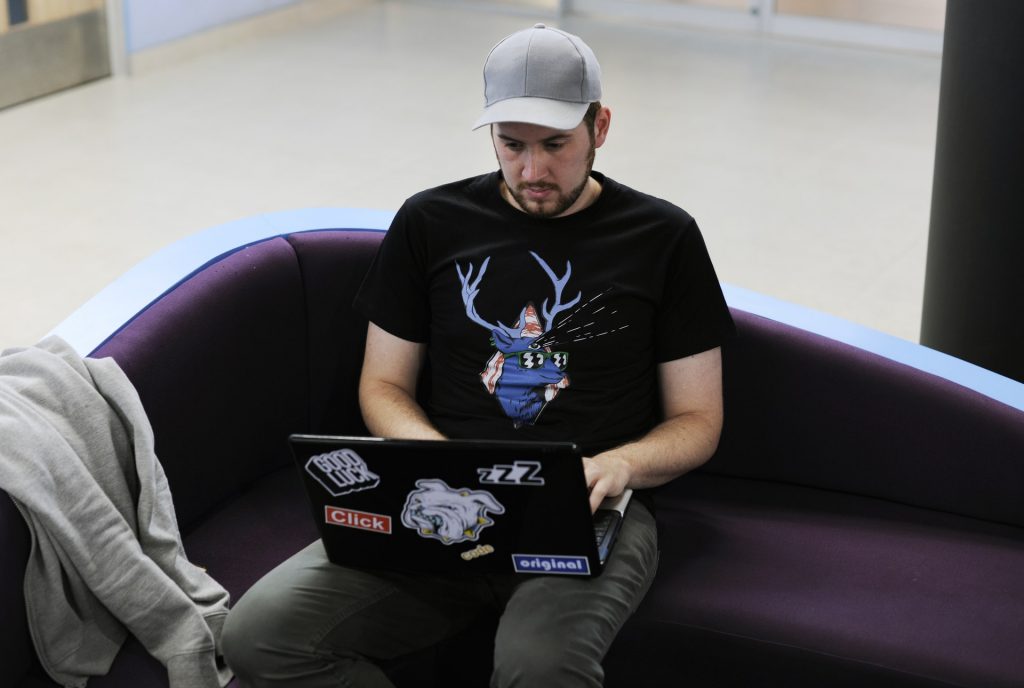
An Outside Perspective on...
The importance of culture
At Microsoft, the term ‘growth mindset’ isn’t a hollow buzzword that’s hung on the wall. It’s the widespread belief that every single person here can grow and develop. It’s about the leadership bringing out the best in people. It’s about constantly improving and challenging ourselves.
When a person accepts that they don’t innately know everything, they eradicate their limitations. They remove their ceiling for knowledge and growth. It’s from this growth mindset spirit, that the seed for this Outside Perspective series was planted.
We begin by looking at the importance of culture. While it’s clear that companies are aware of the importance of technology when it comes to remaining competitive, digital transformation isn’t just an exercise for an organisation’s IT department. It’s also, crucially, very much a people journey.
Our research findings have shown that without fostering the right culture, transformation will never truly be successful.
I spent some time discussing the importance of culture with Dr. Michael Parke from the London Business School, with a particular focus on the important role that organisational leaders have in getting the best out of their employees. Our conversation is presented below, and I hope it provides some useful insights.
.
 Michel van der Bel, Corporate Vice President Microsoft EMEA
Michel van der Bel, Corporate Vice President Microsoft EMEA
As Microsoft President for EMEA, I work with 20,000 employees across 32 subsidiaries with a single vision: to help customers transform to compete in a world where technological innovation is moving closer to the heart of every business. I’ve worked with three CEOs over 20 years and have seen first-hand how they developed the culture around them. I’ve learned that people can only be at their best if they can collaborate in an environment that encourages empowerment, which is why I believe that culture is so vital to every organisation.
MvdB: Let’s start with a classic Peter Drucker quote – “culture eats strategy for breakfast.” How do you see this from your research perspective?
MP: You can have the best strategy in the world, but if you can’t execute it, it doesn’t matter. If a company has a culture where everyone knows their role and how they’re contributing, while standing for common values, then you have huge coordination and cost efficiencies. For example, you don’t have to spend resources making sure people are doing their jobs. Execution absolutely comes down to culture, and that’s critical.
MvdB: How would you define culture? I imagine it’s quite a broad term that can mean many things to different people.
MP: Looking at the research, culture typically has three ingredients. The first is how common values are shared and understood across an organisation. The second is the behavioural expectations which align with those values. For example, integrity – what does that mean? Does that mean I stay true to my thoughts and opinions even if I disagree with leaders of the organization? If your organisation isn’t clear on that, as an employee, you could find yourself in a situation where you keep quiet in a discussion, as you don’t want to get in trouble or be seen as a risk taker. The third component is the shared understanding of methods used to solve problems, such as allowing people to work remotely, or deciding how much research is needed before decisions are made.
MvdB: What is one of the largest hurdles when it comes to creating a culture that encourages productivity? Is time our biggest enemy, or is it engagement? To clarify, should we spend more focus and attention on ensuring there are less distractions?
MP: Time is important, but it is really about quality time on task, which boils down to engagement. From a research perspective, engagement consists of three things, starting with how much time and effort you’re putting in. Second, is how emotionally engaged you are – your enthusiasm, your excitement, your intrinsic motivation. Lastly, we have focus – are you concentrating, or in an environment where you’re easily distracted? So it’s not just about the time spent or available for a task, it’s how much of your full engagement is on that task when you’re deciding to work on it.
If employees are investing their full efforts, they’re engaged. It doesn’t feel like work anymore. They enjoy it, and they’re fully concentrated, which means you’re going to get better results.
MP: Individuals already find it very difficult to live by their own values, especially when they’re facing professional and personal pressures in their lives. Getting an organisation of 10,000 people to adopt the same values can seem insurmountable, but there are mechanisms that can help. If you want to focus on a particular value, such as autonomy, for example, then you need to define what that looks like, and the trade-offs that come into play. For instance, autonomy means employees have the freedom to determine where they complete their work as long as they meet the performance standards, but this cultural value of autonomy may cause coordination issues at times, so how can the organization protect against those side-effects?
Leadership is also crucial. Leaders have such a disproportionate influence on the culture of a company. Not only are they implementing the values that they care about and the expectations that are important to them personally, but leaders are also directly in the spotlight, and people look at them to understand what an organisation is all about and what it sanctions.
The third area is looking at company practices, routines, and policies. Do they all facilitate and strengthen the behavioural expectations of the people working there? If a leader suppresses an employee’s challenge or diminishes an employee’s concern, for example, it shows that the company doesn’t truly want empowerment even if it claims it. In contrast, a company that’s true to its value of empowerment will seek such challenges and concerns by employees as learning and growth opportunities.
Companies must reflect on their values and policies – do they encourage the behaviours that they want, or at times, are they diluting them and actually preventing those behaviours that their values supposedly encourage?
MvdB: Reflecting on our own transformation at Microsoft and that of the customers I talk to, I find that every company, given their context, their culture, and their history, is very different. There is no one-size-fits-all solution to transformation. Speaking to CEOs around the world, it’s clear that transformation isn’t just about technology, but also about how people can change their companies. Everybody is undergoing transformation themselves. There is no playbook. Transformation is hard. You can’t buy it. You can’t delegate it.
Within Microsoft, we want people to be risk-takers and to be bold, which is great, but at the same time, we must also decide what to do if those risks fail. That’s the acid test which determines the difference between a company with real values that are followed through, or one that simply wants to present themselves in an ideal way.
MP: Every organisation has the potential to have a unique culture, but not every organisation succeeds in having one – they can’t always execute it properly. Anyone can pick quirky, fun values that represent some sort of ideal culture, but it’s much more different to actually live it. Ultimately, it comes down to the people. Often in conversations about culture, I tell leaders to imagine the perfect team in your company, and describe how they operate, how they share knowledge, how they strive for their goals. Strong culture is basically duplicating or replicating this ideal team over and over again, across the entire company.
In building culture, mechanisms that resolve setbacks are also important. Ultimately, frustrations that surface often result from a conflict with the culture. What if people don’t take risks, for example, due to budget constraints, or the fear of being punished for failure? Culture grows over time, and if you don’t resolve these friction points, your culture is not going to grow in the way that you want.
MvdB: That’s an important point. At Microsoft, we have three leadership principles – create clarity, generate energy, and deliver success – which are memorable and relatable, letting people assess their decisions against them on a daily basis.
One other point I’d like to bring up, is the hiring process. If you’re interviewing leaders for a position in a company, how do you assess their compatibility or ability to adopt the company culture? Is it their ability to change? Is it about having a growth mindset? Or are there other dimensions that you need to take into account?
MP: The companies that are truly stars when it comes to the culture hire slowly and have multiple layers in the hiring process to make sure they are hiring the right people. One of those layers is typically screening for the cultural fit, such as the right personality or growth mindset or learning attitude.
After that, companies often present specific case studies to see how potential new employees would operate and react in these organizational situations, to see if their decisions or actions would align with the company’s principles. The final layer, which can be the most effective at determining cultural fit, involves having potential employees actually work at the company, paid on a trial basis.
MvdB: Speaking of leaders, what does pressure do to leadership behaviour and cultural behaviour? What mechanisms can be put into place to help people cope?
MP: In times of pressure and adversity, people’s characters are often revealed. What is someone like when things are tough, and stressful, and busy? Are they negative? Are they resilient? I think it’s good to pressure-test people. Recovery is also crucial. Take sports as an example – what is fitness? It isn’t just strength and endurance, or how hard you can push, or how long you can run for. It’s also how quickly you recover. Do organisations encourage that too? Do they realise how hard they push employees? And do they provide breaks or opportunities for rejuvenation? I think every organisation really need to ask themselves if they’re providing these recovery opportunities, which then build endurance and fitness over time.
MvdB: Yes, that’s super-critical, I think, in these times. Have you seen companies responding to this in a positive way?
MP: I think one best practice that you see great companies using is with this empowerment approach is that they trust that employees will know their own energy levels better. They know when they’re getting tired, and as long as they’re doing good work, those companies are happy to provide the opportunity to work from home, to do half-days, to have break rooms or workout rooms, or cafeterias and even psychologists or professional coaches to help build effective work and recovery habits. These resources empower people to use them when they need them.
This model works well because you’re not dictating what people need to do, but you’re recognising the importance of making sure that people can manage their own energy, emotions, and work life. Ultimately, you’re empowering them and trusting them that they’ll do what’s right for them, and for the company.
MvdB: For me, at Microsoft, I feel that the empowerment is leading to people feeling more accountable. Have you seen similar observations or examples?
MP: Yes, because empowerment is not just autonomy, it has four key components. It’s meaningful work where people feel they’re contributing to others. It also means that they have confidence in their abilities to perform their work. The third is that they have impact, meaning that they can influence aspect of their unit or group or organisation. And the fourth is the autonomy aspect, where they can determine how and where to do the work. When you have people who feel they are doing meaningful work, have confidence, and are making an impact, this increases accountability to the organization.
However, when people only think of empowerment as autonomy – meaning that they can do what they want and when – then accountability can become an issue and a concern. But when you think of empowerment as those four things, then that can be extremely powerful.
MvdB: How realistic can we be about the speed of cultural change, because it’s clearly a journey that involves many things. Can it get faster traction than people perhaps think?
MP: If employees understand the benefits of any type of change, it’s much easier to get them on board. Changes in behaviour can be a slow process, especially when you need to bring awareness to a new set of values that justify them. Does everyone agree to them? If not, organizations need to help employees understand and evolve, before holding people accountable to them. That takes time.
Ultimately, culture is about how we do business, how we solve problems, and how we work together. That’s why it’s such a powerful mechanism – and that’s where technology comes in.
Technology changes how we solve problems, which is why it has such a powerful effect on culture and cultural change, because people are doing work differently.
MvdB: You provided some input and expertise into our digital culture study, in which we asked people about their relationship with technology. What’s the impact and connection between technology, culture, and how people actually do their best work?
MP: The study shows that having a strong culture which supports people being at their best, combined with technology use, can increase people’s productivity, engagement, and creativity. When a company has a worse culture – whether generally or technology related – we don’t see those positive increases. That shows that technology is like any other tool we can use to do our work – if we have it integrated into the way we do our tasks and our values, then it can have these positive effects. But if people are using technology without a strong culture supporting it, then you’re not going to see those benefits.
MvdB: Where should people start when it comes to culture, technology, and their digital transformation journey?
MP: We must ask ourselves why we are adding a particular new technology to the workplace. What problem is it solving? What is it helping us do?
A lot of times, technology is sold in terms of features, and that may attract attention, but it doesn’t change behaviour and it doesn’t sustain persistence because the benefits aren’t entirely clear. Is this technology going to create a strong desire to use it because it has multiple benefits to our work? Is it highly visible, so that it gets used? Is it intuitive? Does it encourage habits and routines? These are all critical starting points for technology introduction and change, and I’d love to see your perspective on this, given your unique position at Microsoft.
MvdB: I would take Teams as an example. What does it do about bringing out the best work in people? And what do you do if you’re a big enterprise company providing this technology to three generations of people working in the same workplace? How do you create an environment where everybody will have the opportunity to feel that this is part of how they can do a better job and collaborate?
Microsoft Teams has taken these thoughts into account, rather than just churning out sets of features without purpose. Teams is seeing great usage from our customers, which is telling us that it was designed with meaning and thought behind it, versus potentially rolling it out with sets of features that no one is using.
The way technology is evolving can not only create an environment that enables people to do their best work, but that also supports the cultural and behavioural changes needed to transform.”
MP: Another key point to the adoption of technology, are the differences in not only employees’ ages, but also people’s preferences and technological skills. Good organisations bring awareness to the different ways that people work, before coming to a collective agreement with their employees about how new technology, like Teams, can work for everyone going forward. People are then held accountable to those common and agreed-upon rules.
MvdB: What do you see as the future of this importance of culture and technology, and what are the trends that are pointing to that future?
MP: The core aspects of culture—values, behavioural norms, and problem-solving methods—are always going to be a major component to a company’s success, and these fundamental aspects are not going to change going forward. In terms of forecasting culture, what you’re going to see is that the specific content of those fundamental aspects is going to be shaped by new technology as it changes the way that we see and do business.
Thus, the domain content of what culture is, what it means, and what the values are is changing. Transparency is a good example. Should an organization value transparency and be proactive about showing We’ve seen poorly handled examples of this where videos are posted online in situations where employees treat customers in ways that aren’t aligned with their company’s stated values. Because technology is forcing companies to become more transparent, I think good companies will start to value it more, and get ahead of it. This is one way in which things will move forward and evolve.
MvdB: We’re all living through transformation and culture changes on a daily basis, and that makes it such an interesting topic. If you think about how we as a company are transforming, it has taken three years to get to this point, and we’re far from perfect, but I’m really happy with our progress, and it’s really encouraging to see how we can work together to help other companies on their transformation journey.




















